Some people have this idea that launching a new product will automatically work. Unfortunately, for successful startup development that's not the case. Users will not stand there and ask to try a new mobile or web app the moment you launch it. And for many founders who have never thought of these questions before, like "How do I reach the world?" this actually comes as a surprise.
Paul Graham in his article "Doing Things That Don't Scale" stressed that as a founder, you need to keep different skill sets in mind as your company grows. This article will focus on the top 3 startup growth elements: product-market fit, product growth channels and making decisions with A/B testing.
Product Market Fit & Retention
Product-market fit (PMF) happens when a market buys the product you’ve built. All products and features need to find product-market fit in order to survive.
Product-market fit is a thing that's been hard to measure, and even harder for entrepreneurs to state: “I have product-market fit”. A lot of people like to tell themselves that they do have product-market fit. It's this thing that we throw around as a way to say, "My product is great, so now I have product-market fit."
We would argue that there's some ways that you can measure product-market fit. One of them is 1) choosing a metric that accurately represents the value people get from the product and 2) a frequency within which we expect that value to be used. Let's go through a few real-world examples.
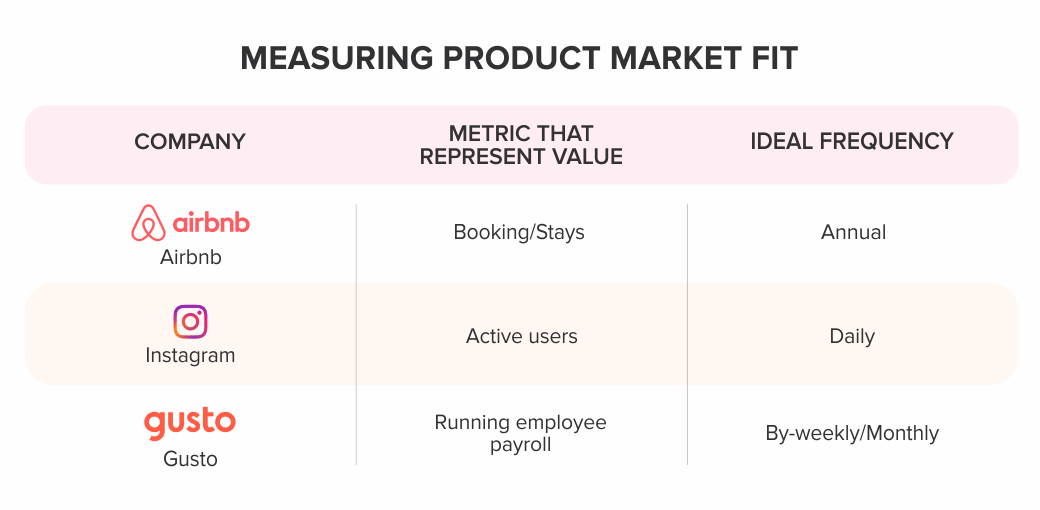
A great example might be Airbnb. What is metric represents the value? It's the bookings and stays. It's not the searches since when someone travels and uses Airbnb, they've experienced the value. How often do people do this? Travel is actually mostly an annual thing. You don't really travel every month. So, when measuring retention at Airbnb (or similar businesses), we were looking at annual.
On the other hand, what's the expected use case of Instagram? It's basically just coming back to Instagram. Most people are not expected to post photos every day. It is just going to be coming back to Instagram and viewing photos. That's what most people do. And that's fine. That's actually what they want. They want some people to post photos sometimes, but most of the time just coming back is good enough. How often? Probably every day.
Let's think of a B2B company, Gusto. So, for Gusto, the most valuable thing that they do for their customers is they run payroll. And they pay out money to the employees of Gusto's customers. So, how often do you run payroll? Well, it depends, probably every, biweekly, or monthly. And by measuring these two things, how many people am I running payroll, and are they continually running payroll with me? That's probably the best way to figure out if people enjoy using Gusto if they're gonna switch to some other payroll provider.
Let's put on graph those metrics to illustrate the retention. If you're ever going to raise money, this is a graph that investors are going to ask for. Like, how much retention do you have? And are people actually repetitively using your product?
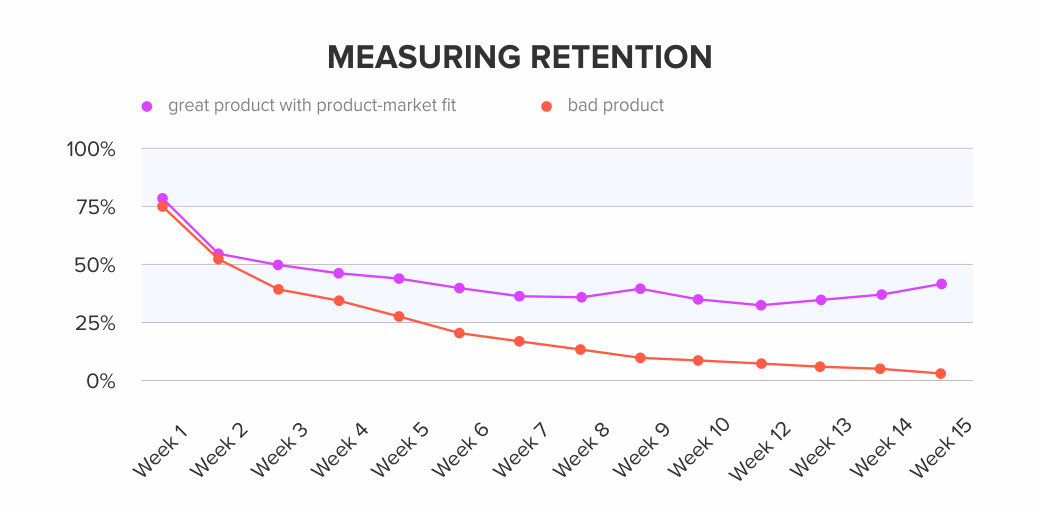
One-piece on the graph is going to be the metric, and the other one is going to be the time. So, every single time window, we can put some percentage of those people on the graph. For example, Uber metrics are riders (the people that are taking the rides) and the action that they take on a weekly or monthly basis. So, on week zero, in the case of Uber, you had a hundred percent drivers. This means that if I had, say, 10 riders this week that rode with Uber, they would be calculated on the week zero. Now, how many of the riders that I had last week are now traveling with Uber this week? That is your week one number, and the week two number, and etc.
Here we're trying to measure repeat usage. Repeat usage is the best, most unbiased way to figure out if someone is liking your product. It's more true than what customers tell you. So, even if I'll pay for Gusto on an annual basis, which they don't do, measuring the activity using Gusto on a regular basis, let's say biweekly or monthly, is the way to figure out if people are actually using the product.
The good product (purple line on the graph) means that every week, it eventually flattens out, and the people that stop using the product. And eventually, at week 8, 9, 10, there is a flat line of people that continue to use the product every single week. That means that they are retained. You have a product-market fit for those users for this product.
So, I'm not going to ask you these questions, but here are two examples of two companies that I would argue have product-market fit. The first one here has 30% after two months, and 21% after 20 months. This is pretty good. So you kept a fifth of your users 21 months later, or 20 months later. It's DoorDash. DoorDash has monthly retention of 20% two years later, a year and a half later.
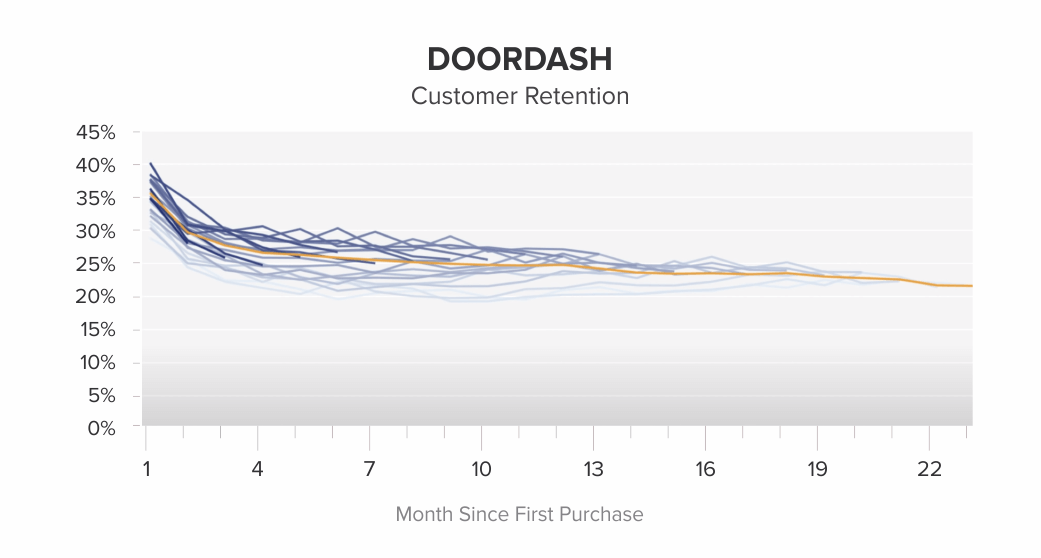
Here's another company, more like a B2B company. So, 80% retention after one month, and then 30% after 60 months. This is really good. This is a really good product, very sticky. People like this product and they don't stop using it. It's GitHub.
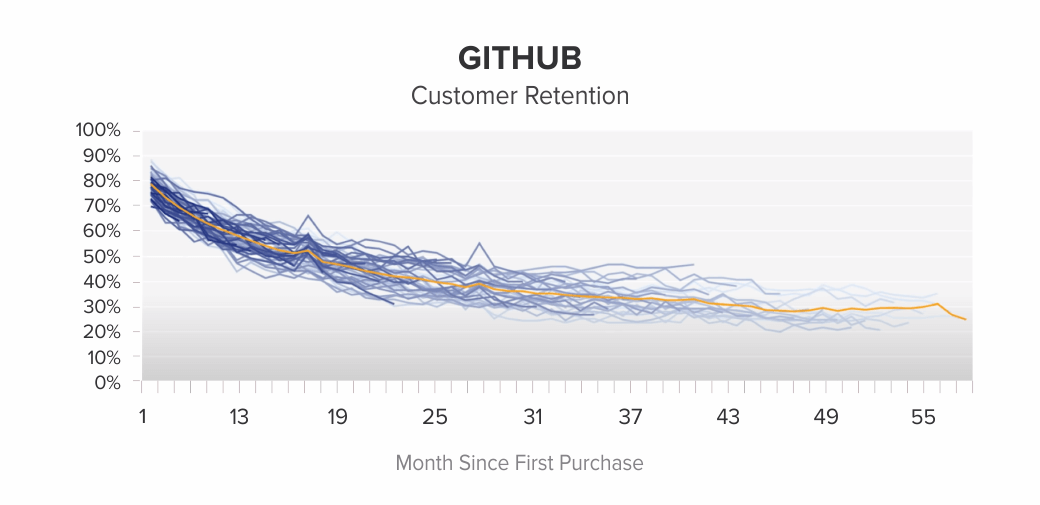
Other ways to measure PMF which is not good
Net Promoter Score. It’s not good since it doesn't necessarily correlate with good products. The best products and best companies in the world have bad net promoter scores (iPhone, Apple). All they have bad net promoter scores. Net Promoter Score correlates with perceptions of companies.
Surveys. The problem with surveys is they are going to be biased. So, if you ask your users, you're going to have some level of bias. There are good ways to use surveys to improve your products, but it's not going to be the best way to figure out this metric.
Asking users "How would you feel if you can no longer use this product?". It can give you an idea, but not the data and you should not do it instead of retention.
These are bad metrics for PMF:
Registered users. It does not say anything about repeat usage, or if they liked you or not.
Visitors. The metric does not say anything about whether your product is going to be valuable.
Conversion rate. "We have this conversion rate of visitors to something else." That doesn't really say much, because you don't know what people you're converting. You don't know who they are. So, this is not saying much about product-market fit either.
Growth Channels & Tactics
Working on growth channels and tactics only makes sense if you have PMF. If most of the people that come to your product go down the drain right away and they never come back, this section doesn't matter. Like, why would you work on trying to get more people to a product that no one is using your product anyway?
Wait with working on growth channels until you have some people that care about your product, and you can try to use some of these channels to reach those people specifically.
There are really two ways that you can grow at scale:
Work on product growth, or conversion rate optimization. What this means is you have typically engineers, designers, data scientists, product managers, working on improving specific parts of your product to get more people through that funnel.
Work on growth channels. Growth channels are basically other platforms but your website, or your mobile app. For example Google. It's a huge platform for new products to be discovered. Another way might be ads on social media, like Facebook and Instagram. Advertising on Facebook and Instagram is critical to companies' growth these days.
Product Growth: Conversion Rate Optimization
Your product is a growth loop. Every single step of your product experience is a funnel that, like the retention curve, can be measured. If you put a metric on every single page in your product, you will know what percent of people make it from the first page, say the home page, to the booking page.
For example, for a booking platform, you can call the homepage P1, the search results page P2, and the listing page P3, and then the booking page was P4. The funnel is the percentage of people that make it from P1 to P4. Most people don't make it that far. So, your job is to figure out how many people make it that far? Why are they dropping off? What can I do to increase the number?
Product Growth: Growth Channels
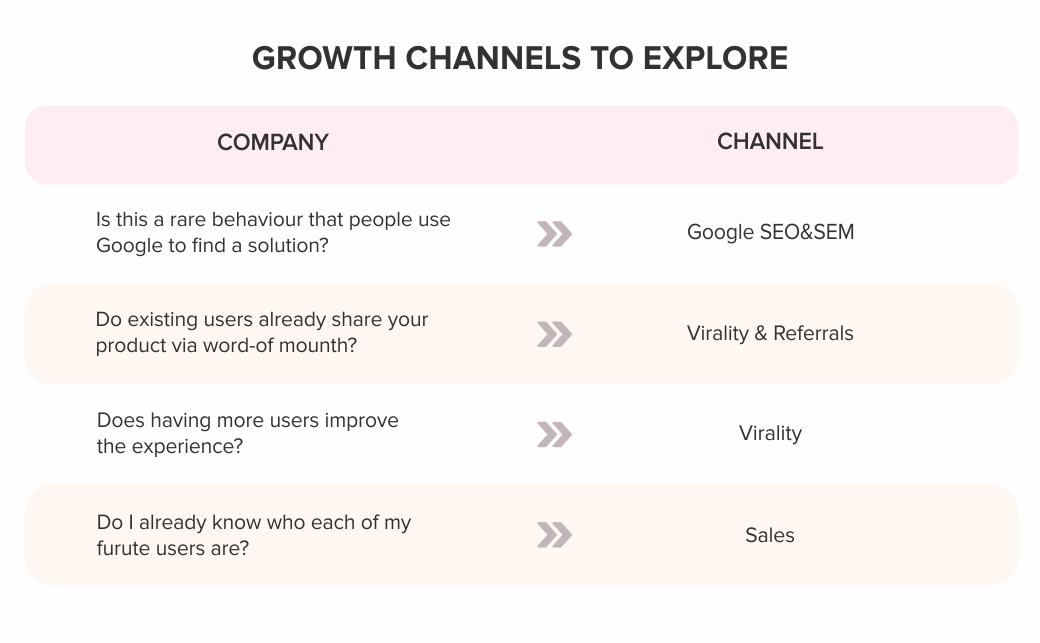
Goggle SEO & SEM. First one, if this is a rare behavior, most new ideas are rare behaviors, either because they don't exist yet, or because they're not something you do every day. We tend to go to Google to learn about things that we don't do very often. So that's why, if that is the kind of product that you have, being on Google is going to be really important. You can either be on Google through paid marketing, through SEM, or through SEO.
Virality & Referrals. Second, do the people already share your product through word of mouth? So, some products are viral in its nature because it sounds really exciting to talk about. Uber and Airbnb are examples of those. If that's the case, you want to make sure you focus on virality and referrals. What does that mean? Means you're building into your product a flow that friends can tell other friends about the product. Referrals are a way that you can do that by giving some kind of financial incentive.
Virality. Does the product get better if you have more users? Well, this is true for marketplaces. But it's specifically true for anything that's social. So, if you think of a LinkedIn or a Facebook, then having more people on the product is going to make it better. So it's going to be really important for you to get more people, and those people on your site are going to be the ones doing it. So you want to figure out a good viral loop. So, when you sign up for LinkedIn, the first thing they ask you is to invite more people. That's because your experience gets better when there are more people on LinkedIn. Now, many products do work this way, and this can be perfected. And the ones who really succeed in the world of a social product are the ones that really nail this down. They figure out how to do this really well. Many people that make social apps underestimate how important it's going to be to get your friends on that product.
Sales. If you can make a list of all their customers, even if that list is 100,000 or 500,000, as long as it's not mainstream enough that it'll be in the tens of millions, you're probably gonna do sales. You'll make that list, and you start counting those people. Why make it any more complicated? Why go out and reach the world if there are only a few people that you really want to reach?
This is a channel that nowadays is bigger than it ever has been, and more important than it ever has been it’s called a high LTV, high lifetime value. By getting a high lifetime value, you're enabling the ability to buy paid advertising. If you don't have people paying for your product, where you're making money from your product, you should not be spending time on online marketing. Now, the truth is that most companies these days are charging for the products, and they are making money from the product, and therefore they spend money on online marketing. If that's true for you, this can mean an extremely powerful channel. The biggest mistake founders make is to start working on online marketing when they don't have people paying for the product.
Most really big companies didn't use all of those channels. They use one or two channels. So, think of a TripAdvisor. How is TripAdvisor big? SEO. You guys type in something on Google, you land on TripAdvisor, and that's how you found this website. Most companies have a setup where there's gonna be one or two channels that really matters. If you think of Pinterest, SEO is the real way how Pinterest is growing. You type something on Google, there already exists a Pinterest board for that, and you land on that Pinterest board. That's how they acquire new users.
Making Decisions with A/B testing
Most founders don't have to focus on A/B testing at all. It won't matter for a long time. It is a great decision-making tool later on. First, before you get into that stage, you want to figure out, "Is A/B testing something I want to do?" The best way to do that is to go to Google and type in "A/B testing calculator".
For example, you thinking of changing the design of your website or mobile app. A/B testing provides you with different parallel universes at the same time, one with the new design and one with the old design. If I had that, I can tell exactly what happened. That's the definition of A/B testing. You basically have two different parallel universes of the thing you shipped at the same time, and you measured the metrics that matter to you. The reason this is so powerful, it helps you make decisions at scale.
Conclusion
At the beginning of your company, you're going to do a lot of things that don't feel right. But later on, as your company grows bigger, you're going to be doing a lot of things that directly related to software, are things that scale to the company. Building a startup is huge work and to do it efficently you should pay attention to the main components that will eventually lead to growth of your small business.
Drop us a line if you have any questions about startup development and we'll gladly help you in any inquiry.





